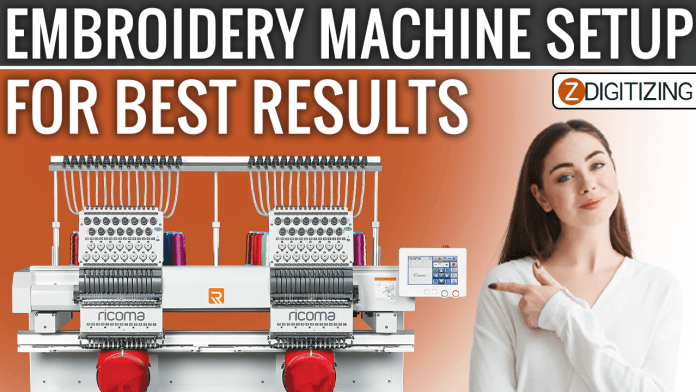Introduction
Embroidery has been an art form that has captivated and adorned fabrics for centuries. In the modern era, technological advancements have given birth to embroidery digitizing services, revolutionizing the way intricate designs are translated onto fabrics. One of the critical aspects of achieving exceptional results in embroidery lies in mastering the embroidery machine setup. In this comprehensive guide, we will delve into the world of digitizing for embroidery and logo digitizing, uncovering the steps and techniques required to set up your embroidery machine for the best results.
Understanding Embroidery Digitizing Services
Embroidery digitizing services have transformed the traditional manual embroidery process into a precise and efficient digital art. Digitizing for embroidery involves converting intricate designs, logos, and artwork into a format that an embroidery machine can understand and replicate. This process requires a deep understanding of design principles, color theory, and the capabilities of embroidery machines.
1. Design Preparation
Before delving into the embroidery machine setup, the first step is to prepare your design for digitization. This involves cleaning up the artwork, simplifying complex details, and optimizing colors for embroidery. Remember that intricate details and small lettering might not translate well onto fabric, so it’s crucial to adapt the design to suit the embroidery medium.
2. Digitization Process
Once the design is ready, it’s time to digitize it using specialized software. Digitizing software allows you to assign stitch types, directions, and densities to various parts of the design. This step is critical, as the quality of digitization directly impacts the final embroidered result. Each stitch type serves a different purpose, such as satin stitches for smooth surfaces and fill stitches for larger areas. Careful consideration of stitch length, density, and underlay is essential to ensure the design’s visual appeal and fabric stability.
3. File Formats
After digitization, you’ll have a digital embroidery file in formats like DST, PES, or EXP, which are compatible with different embroidery machines. Choosing the right file format is crucial, as different machines may have varying compatibility requirements. Consult your embroidery machine’s manual or manufacturer to determine the ideal file format for your setup.
Embroidery Machine Setup for Optimal Results
With the digitized design in hand, it’s time to set up your embroidery machine for the best results. Follow these steps to ensure a seamless setup process:
1. Material and Hooping
Selecting the right fabric is vital for achieving optimal embroidery results. Choose a fabric that is compatible with your design and embroidery machine’s capabilities. Additionally, ensure the fabric is properly stabilized using techniques such as backing or topping to prevent distortion or puckering during the embroidery process. Proper hooping of the fabric is equally crucial. Make sure the fabric is taut and evenly stretched in the hoop, avoiding wrinkles or slack.
2. Thread and Needle Selection
Selecting the appropriate thread and needle is essential for achieving vibrant and accurate embroidery. Choose high-quality embroidery threads that match the colors in your digitized design. The thread weight should be compatible with the fabric to prevent tension issues. Similarly, choose the right needle size and type based on the fabric’s weight and texture.
3. Tension and Thread Path
Proper thread tension is the key to achieving consistent and well-defined stitches. Consult your machine’s manual to adjust the tension settings accurately. Follow the recommended thread path to ensure smooth thread flow and prevent thread breaks or knots. Incorrect thread path or tension can lead to uneven stitches or even damage the fabric.
4. Bobbin and Bobbin Case
Check the bobbin and bobbin case to ensure they are clean and properly threaded. A well-maintained bobbin case contributes to even thread tension and prevents thread tangling during embroidery. Make sure the bobbin thread matches the top thread in color and weight for a harmonious design outcome.
5. Machine Settings
Refer to your embroidery machine’s manual to set the appropriate speed, stitch length, and density settings for the specific design and fabric you are using. Adjusting these settings ensures that the design is embroidered accurately and without any fabric puckering or distortion.
6. Test Run and Adjustments
Before embroidering the final design, perform a test run on a scrap piece of fabric. This allows you to identify any potential issues, such as thread tension problems, stitch misalignment, or color discrepancies. Make necessary adjustments based on the test run results to ensure a flawless final product.
Logo Digitizing for Professional Results
Logo digitizing requires extra attention to detail to accurately represent a brand’s identity. Here are some additional tips to consider when digitizing logos:
1. Simplification and Clarity
Logos often contain intricate details, gradients, or fine lines that may not translate well to embroidery. Simplify the logo design while retaining its core elements to ensure clarity and legibility when embroidered.
2. Color Consistency
Maintain color consistency between the original logo and the embroidered version. Use a thread color chart to match the logo’s colors as closely as possible, ensuring that the brand’s identity remains intact.
3. Size and Placement
Consider the size and placement of the logo on the garment. Logos that are too small may lose detail, while oversized logos can appear distorted. Carefully measure and position the logo to ensure it fits the intended space and maintains visual balance.
Conclusion
Embroidery digitizing services have opened up a realm of possibilities for translating intricate designs and logos onto fabrics with precision and finesse. Mastering the embroidery machine setup is the key to achieving optimal results that capture the essence of the digitized design. By following the steps outlined in this comprehensive guide and paying attention to crucial details, such as design preparation, thread and needle selection, tension adjustment, and test runs, you can elevate your embroidery projects to professional levels. Whether you’re creating custom apparel, promotional items, or personalized gifts, a well-executed embroidery setup ensures that your designs shine vibrantly and impressively on any fabric canvas.
